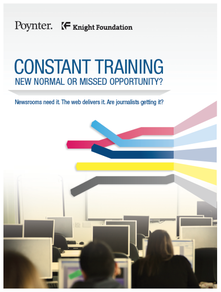
Eric Newton: Why I’m worried about newsroom training
Way back in 1938, Agnes Wahl Nieman’s bequest launched a fellowship program at Harvard to “promote and elevate the standards of journalism.” Even then journalists wanted to know more, not just about the skills of our craft and the issues of our profession, but about the complexities of the topics we cover in trying to make sense of the world.
Related Link
“Constant Training: New Normal or Missed Opportunity?” by The Poynter Institute
In the decades since, training has gone from an add-on frill to a survival skill. Journalists and newsrooms that can’t reinvent training in the digital age will face at best a bleak future.
Today, a Knight Foundation-funded report by the Poynter Institute looks at training in 31 newspaper newsrooms. The report — “Constant Training: New Normal or Missed Opportunity?” – worries me.
Some findings weren’t surprising. Most journalists received some kind of training in the past year. The 1,118 journalists surveyed said they were learning more on their own. The more they learned — especially digital skills, but also writing, investigative reporting, change management and audience development – the more they wanted to know.
Most saw their training as part of a company plan, but if the plan was to become a digital news organization, that hasn’t happened. Only a third of the journalists surveyed said their newsrooms were leaning digital or digital-first. That’s worrisome.
I’m uneasy with what by the old yardstick can be seen as growth in U.S. journalism training. In 1992, when I co-wrote “No Train, No Gain,” only 14 percent of the journalists surveyed had any type of regular training. By 2002, when Knight Foundation produced “Newsroom Training: Where’s the Investment?” the number had doubled to 3 in 10. By 2007, when “News, Improved” was published, it more than doubled again to nearly 7 in 10.
But today’s study says we’re stuck at roughly the same average even as change is accelerating. What’s more, a national survey reports an overall average. In some newsrooms, nearly everyone gets some training; in others, the number can go as low as 17 percent. How can a number get that low when programs such as News University and NewsTrain have wiped out obstacles such as money and time?
Some will say they are trapped under bosses who don’t think well-trained people are faster and better. Others will say their company’s only focus is its cash-cow strategy, milking the business to death, and good journalism has no place there.
But those excuses don’t stop some companies from doing much more and thousands of journalists from learning what they need to know. These folks are as enterprising about staying up to date as they are about their journalism. You can read more about them in “Digital Training Has Come of Age.” You can feel their energy at Investigative Reporters and Editors and the Online News Association.
As a group, sadly, we’re not keeping up. We’re still struggling to sort out the three traditional types of training — craft skills, professional expertise and topic knowledge. Here comes the digital age with a fourth category: “change competencies.” These include curiosity, creativity, currency, flexibility, innovation, iteration and change management. Once thought to be unteachable, they’re now unavoidable. Show me a wholly creative journalist and I’ll show you a person who can thrive in a future no one can predict.
Passionate people can excite in ways aging institutions never will. Former Nieman curator Bob Giles once said no American industry is as dependent upon charity as the news industry is for the training of its own people. That’s the larger truth. Until continuous training is universal, built into either our newsrooms or our own daily routines, print journalists will move at industrial, not digital, speed.
Eric Newton is special adviser to the president at Knight Foundation.
Recent Content
-
Journalismarticle ·
-
Journalismarticle ·
-
Journalismarticle ·



